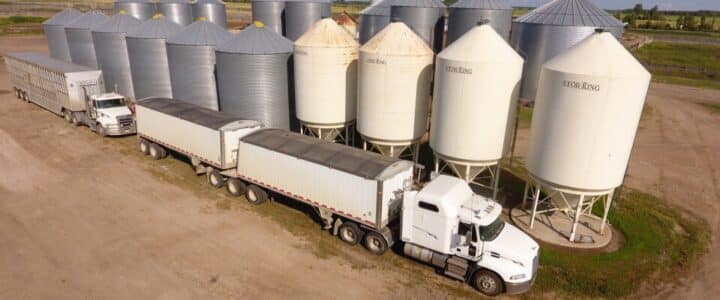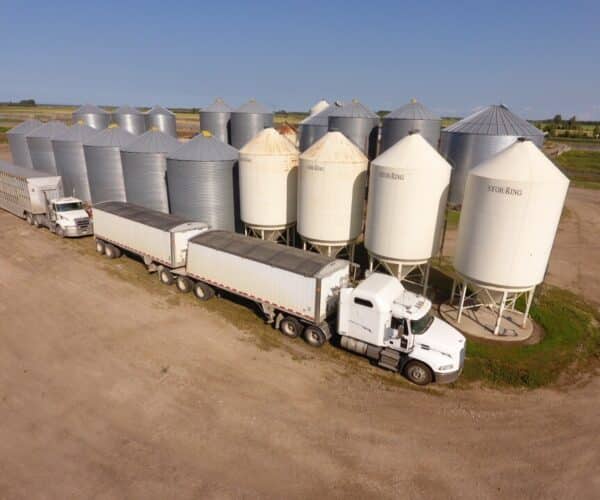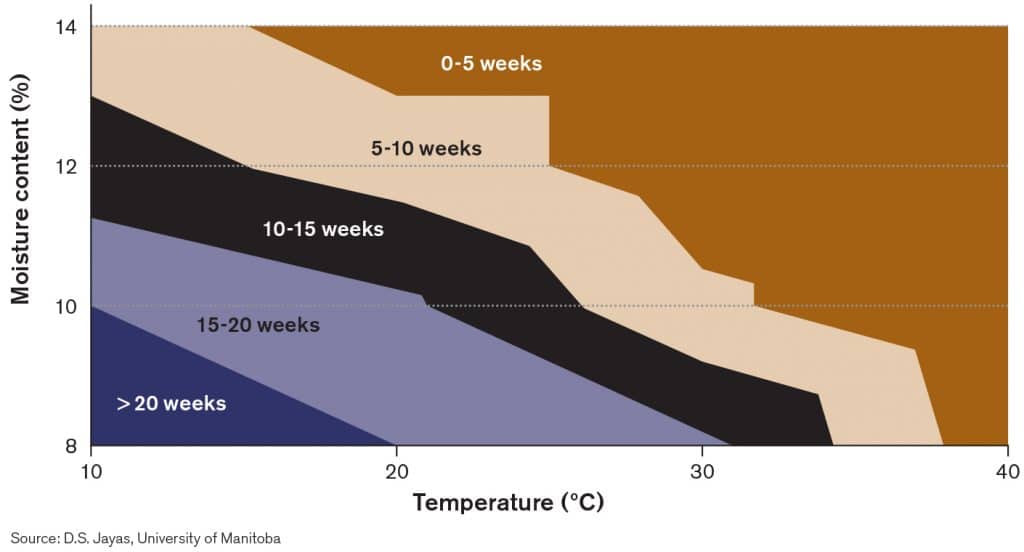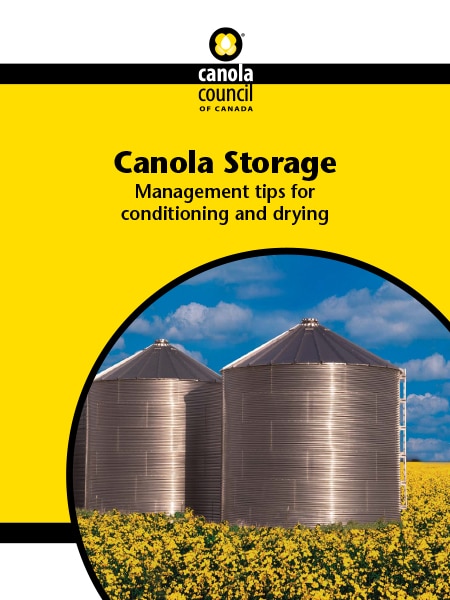Growers all know that maintaining seed quality and avoiding spoilage are key goals of canola storage. To achieve these goals, there are seed parameters (such as oil content, quality, temperature and moisture), bin factors (bin size, fan type and size, quantity, etc.) and environmental considerations (air temperature, humidity, etc.) to manage for varying storage lengths through various seasons. This blog further investigates some of these factors and the impact they have on stored canola in various scenarios.
Seed moisture content and storage temperature impacts on canola seed oil quality
The ‘Long-term storage of canola‘ study led by Nathan Gregg examined the effect of seed moisture content and storage temperature on canola seed oil quality. Samples of clean, standard, green, and high oil content canola seed from the 2009 growing season were conditioned to seven different moisture contents and stored in environmental chambers (converted from upright freezers) to provide five different temperature test conditions (-5oC, 5oC, 15oC, 25oC, 35oC) for approximately four months. The temperature within each of the 140 samples was monitored for an increase that might indicate spoilage.
After two months of storage, the samples were physically inspected and tested for acid value, free fatty acid, peroxide value, and P-Anisidine value. These values were then compared to initial base samples to determine if oil quality had changed. Interestingly, although there was no indication of spoilage based on temperature and limited oil quality reduction (oxidation and oil quality deterioration processes had begun but not exceeded tolerance limits), physical inspection showed there had been spoilage in the form of mold growth in several samples (especially in the 25°C and 35°C environments). When these samples were disturbed, clumps were evident and a musty odour was present.
Apply this research on your farm
- Visually check canola for spoilage along with monitoring bin temperatures. Keep records for insight into the trends.
- Higher oil content canola requires additional monitoring than lower oil content canola.
- Compression forces experienced by canola seeds in tall bins don’t appear to be detrimental to them.
- Separate canola based on qualities such as moisture content or dockage to reduce the risk of spoiling in storage bags.
- Explore CanolaStorage.ca for tips and tools.
Therefore, these long-term canola storage conclusions were made:
- Warmer storage conditions may be more likely to spoil, however temperature increases don’t always coincide with mould growth, so visual observations should be taken along with monitoring bin temperatures.
- High oil content canola appears to begin oxidation processes at lower storage temperatures and moisture contents than canola with lower oil content (but still within acceptable limits), so it requires additional monitoring than lower oil content canola.
- Caution should be used with long-term canola storage, due to oil quality concerns (as oxidation progress in this study suggested).

dockage used in this study (from Table 1. in the final report)
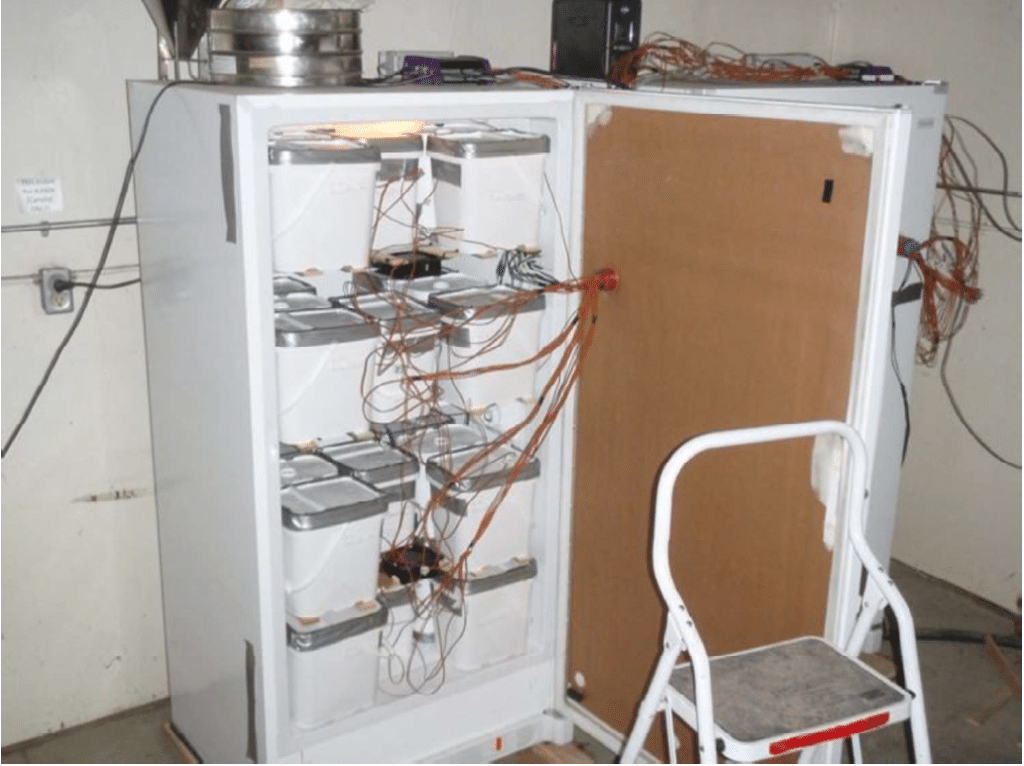
Canola storage compression investigation
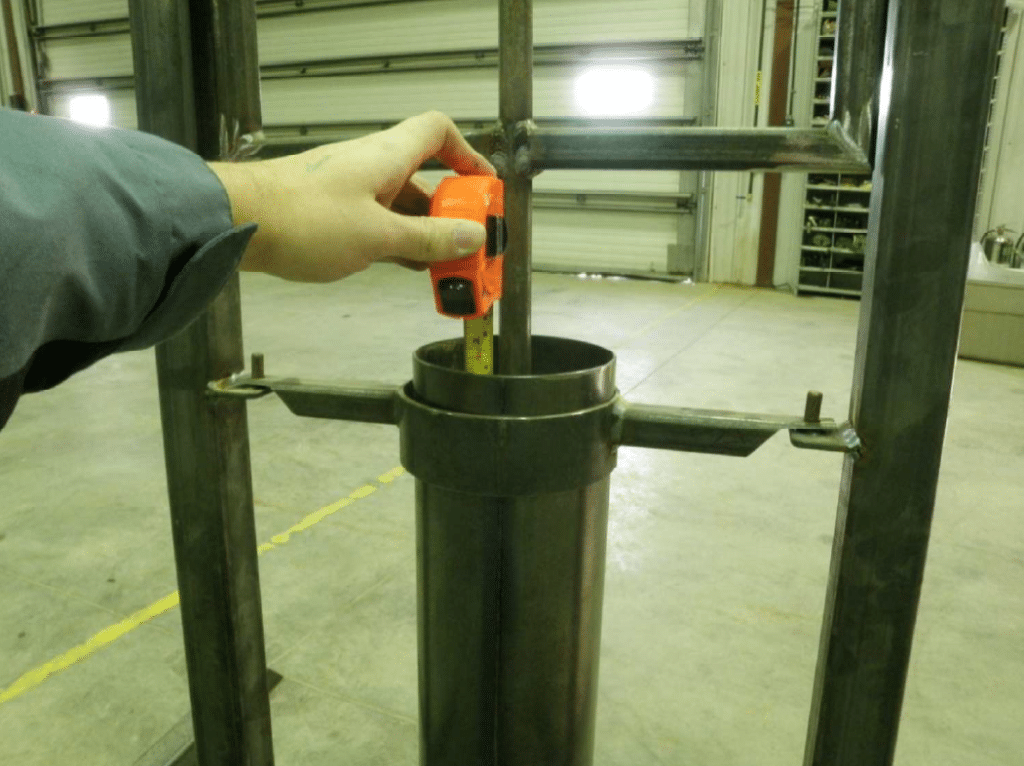

The effect of canola compression under its own in weight in tall bins was also examined in the ‘Long-term storage of canola project. Samples of standard and high oil content canola were monitored under a compression load of up to a 30.48 m (100 ft) column of grain (to simulate pressure in a tall bin), and compressed displacement were recorded. Samples were visually inspected for signs of seed damage and seed shape/deformation, oil exudation, displacement under compression, and seed germination tests were conducted. None of the tested samples showed any negative effect due to the compression.
Conclusions from this compression experiment include:
- The compression forces experienced by canola seed in tall bins (up to ~100 feet tall) do not appear to be detrimental to canola, as the compression is not extensive enough to significantly affect the structure of canola seeds.
- Canola with higher moisture content- may have some seed shape deformation occur, and increased displacement (compaction), but seed coat rupture or oil exudation aren’t common and it doesn’t appear to reduce germination.
- Canola with higher oil content – had no indications of increased seed damage (germination, rupture, and oil exudation), but the effect of seed oil content on structural integrity was not conclusive.
Therefore, storage of high oil content canola in tall bins does not appear to be a risk to seed integrity, based on these tests. However, different moisture content, temperatures, seed varieties, etc., may produce different results.
Proper management for high oil content canola
Digvir Jayas’ ‘Storage and handling characteristics of new varieties of high oil content canola’ project further investigated impacts of high oil content canola stored in bins in three experiments: one on small-scale storage, one on large-scale storage, and one on physical properties.
The small-scale study compared high oil canola and a standard canola variety (cultivar) stored at eight, 10, 12, and 14 per cent moisture content inside environmental chambers at 10°C, 20°C, 30°C and 40°C for up to five months. Samples were removed from the containers every two weeks and tested for germination rate, visible mould, and free fatty acid values. Results reported that after, 20 weeks of storage, canola with eight, 10 and 12 per cent moisture stored at 10°C and 20°C did not have significant quality changes, no matter the oil content. In addition, these findings from were reported from the small-scale study:
- Germination impact: Only canola with 14 per cent moisture had a considerable decrease in germination rate after 10 weeks at 20°C. The germination rate of both high oil and standard canola varieties decreased significantly in a short time when stored at 30°C and 40°C.
- Visual impact: Mould was evident in some high oil content varieties with greater moisture content stored at higher temperatures.
In the large-bin study, canola was loaded into three flat bottom bins inside an environment-controlled room and was initially aerated with humid air to bring the seed moisture content to 10 per cent. Notable results and conclusions from this large-bin study included:
- Visual impact: Visible mould appeared in the top layers of the some bins after six weeks and in all layers in one bin after 10 weeks.
- Germination impact: Germination rates for canola in the top layer of all three bins decreased by more than 20 per cent after 16 weeks of storage.
The results from the physical properties study reported that:
- Bulk densities of both oil content varieties increased with increasing moisture contents (from eight to ten per cent) and decreased with further increase of moisture content (from 10 to 14 per cent). However, the bulk density of high oil content canola was affected more by changing moisture content than low oil content canola.
- Moisture content did not influence repose angles very much.
- The coefficient of friction was not significantly affected by the moisture content but was by oil content, so buildings that are strong enough for low oil content canola could also support the high oil content canola.
Overall the physical properties study concluded that storage infrastructure which is strong enough for low oil content canola could also store canola with higher oil content.
For more details on this study see the project summary page.

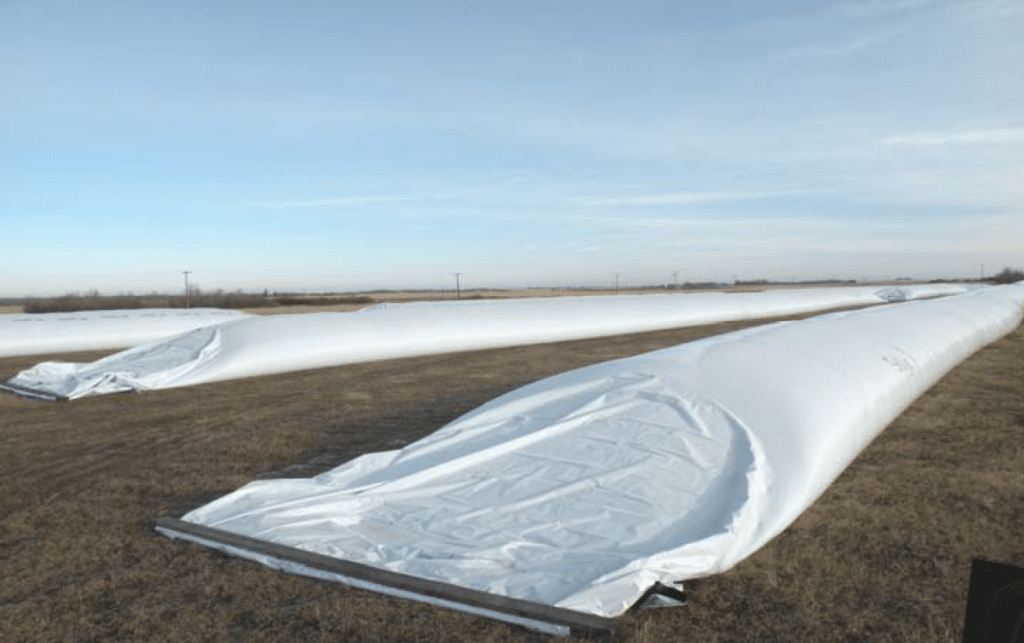
Viability of high moisture canola in storage bags
Even though they may not be used by all growers or in all years, Boyle and Stonehouse’s ‘High moisture canola in bags‘ research reported some interesting findings that could be applicable for any type of canola storage.
Since temperatures were thought to differ along the length of the bag, multiple sites were monitored on the 11 large storage bags (12000 bu). Probes were left in the bag for 2-3 minutes usually to allow the thermocouple temperature to equilibrate, before reading the temperature, and removing the probe. As time permitted, bags were monitored twice per week, and then less often as temperatures either stabilized or cooled. Canola samples taken at (or close to) time of filling and emptying were tested for moisture, dockage, green seeds and damage. Maximum air temperatures were gathered from Environment Canada for the days that bags were monitored.
The main bag storage recommendations generated based on the results of this study include:
- All storage options require monitoring of temperatures, at least twice per week until temperatures stabilize or decrease to safe levels.
- Recording temperatures will offer some insight into the temperature trends and provide valuable information on which to base decisions for moving and drying all crops.
- When filling a bag, make notes, on the bag itself, the location, filling times, grain and air conditions. This may also guide monitoring points within the bag.
- All storage options require monitoring of several locations within the volume of grains or oilseeds, given the potential for differences in quality of grains or oilseeds within a given container. For storage bags, monitoring every 25 feet may be adequate. One might also consider monitoring conditions towards the bottom of the bag. One should not assume similar conditions among multiple bags nor for an entire single bag.
- Given the flexibility of volumes which can be contained in storage bags, there may be advantages to separating grains or oilseeds based on qualities such as moisture content or dockage to reduce the risk of spoiling larger quantities of product in a large single container.
- Cool air temperatures at the time of combining and storage are of tremendous value to prolonging safe storage of canola.
However, it was also noted by the research team that there is a need for more detailed research comparing bin and bag storage of canola, as well as revisit recommendations, given the increasing oil content of new canola varieties.
Additional canola storage research
For more results from bag storage research see:
- Feasibility of bag storage system for canola under Prairie conditions (part 1)
- Feasibility of bag storage systems for canola storage under Prairie conditions (part 2)
For more canola storage research, check out:
- On-farm canola storage research in large bins
- Determining best practices for summer storage of canola in Western Canada (part 1)
- Determining best practices for summer storage of canola in Western Canada (part 2)
- Defining best management practices for using supplemental heating with natural air drying
- New insights into natural air grain drying
- Natural air grain drying testing of an automatic controller for managing bin aeration fans
Canola storage resources for growers
For recommended canola storage best management practices, check out these resources:
- Canola Digest: Storage risk article
- Canola Digest: New tech checks bins
- Canola Watch: Harvest and storage fundamentals articles
- Including: How to check bins for spoilage
- Canola Watch podcast: Canola storage
- Canola Watch video: Canola storage
- Keep it Clean: Canola storage reminder
- Canola Council of Canada’s Canola Encyclopedia: Storage entry
- CCC’s Canola Storage guide
- Safe grain storage interview, featuring CCC agronomy specialist Shawn Senko and researcher Lorne Grieger
- Canola Research Hub blog: Risk factors and important considerations for canola storage
Published October 11, 2022


